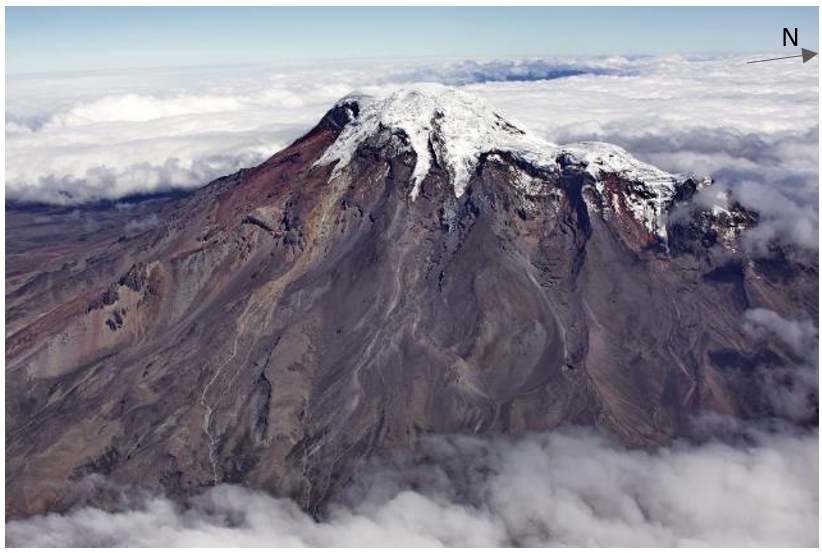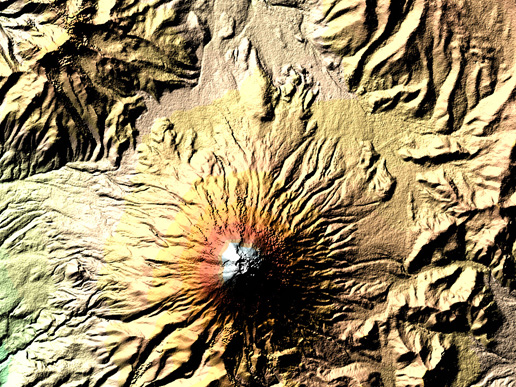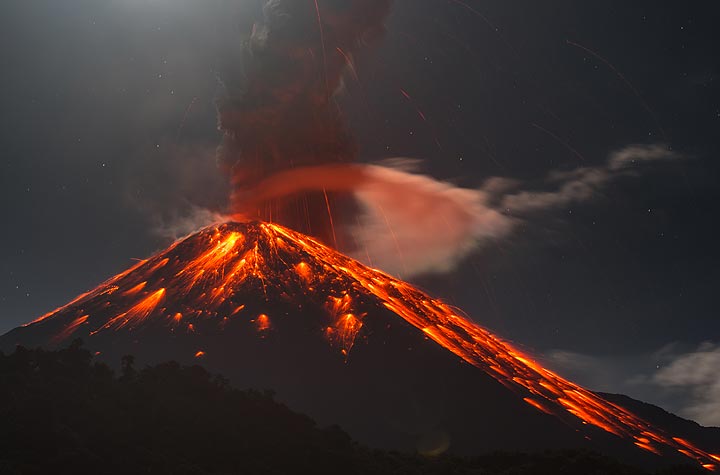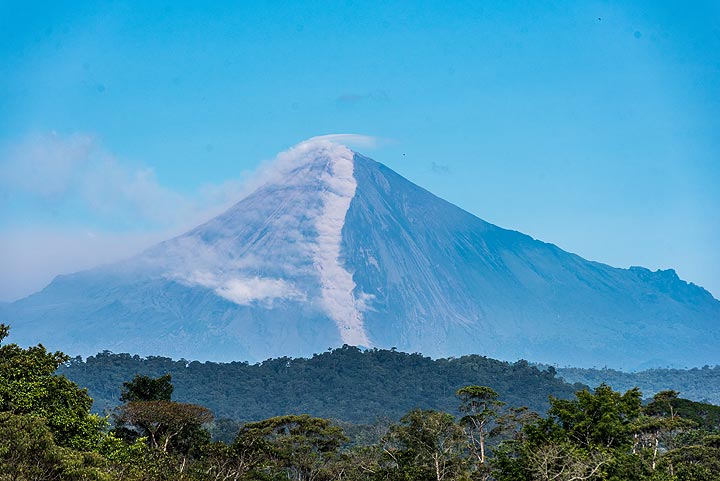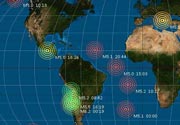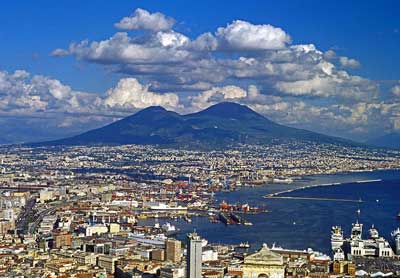The volcanoes of Ecuador belong to the Northern Volcanic Zone of the Andes, which is the result of subduction of the Nazca Pacific oceanic plate under the continental plate of South America. In Ecuador, the volcanoes occur on 4 chains.
All active (and a few extinct) volcanoes of Ecuador are listed.
| Date | Volcano | VEI | Region | Deaths | Damage | |
|---|---|---|---|---|---|---|
| Sangay | 2 | Ecuador | ||||
| Reventador | 2 | Ecuador | ||||
| Cotopaxi Summit crater | 2 | Ecuador | ||||
| 2021 Mar 5 (eruption | Sangay | 2 | Ecuador | moderate | Info | |
| Sangay | 2 | Ecuador | ||||
| Sangay Summit crater | 1 | Ecuador | ||||
| Sangay Summit crater | 2 | Ecuador | ||||
| Sangay Summit crater | 2 | Ecuador | ||||
| Tungurahua Summit crater | 3 | Ecuador | ||||
| Cotopaxi Summit crater | 2 | Ecuador | ||||
| Sangay Summit crater complex | 2 | Ecuador | ||||
| Sangay Summit crater complex | 2 | Ecuador | ||||
| Sangay Summit crater complex | 2 | Ecuador | ||||
| Tungurahua Summit crater | ? | Ecuador | ||||
| Tungurahua Summit crater | 2 | Ecuador | ||||
| 2011 Apr (eruption | Tungurahua | 4 | Ecuador | light | Info | |
| Sangay | 3 | Ecuador | ||||
| Tungurahua Summit crater | 3? | Ecuador | ||||
| 2010 Nov (eruption | Tungurahua | 3 | Ecuador | light | Info | |
| Tungurahua Summit crater | 3 | Ecuador | ||||
| 2010 Jan (eruption | Tungurahua | 3 | Ecuador | light | Info | |
| 1976 Aug 12 (eruption | Sangay | 3 | Ecuador | 2 | Info | |
The last volcanic eruption in Ecuador was from Cotopaxi volcano during 2022 - 2023.
The first historically documented eruption occurred around 1532 AD from Cotopaxi volcano.
Volcanoes in Ecuador erupt almost every year. Since the first historically documented eruption 1532 ADin Ecuador, historic sources have shown nearly continuous volcanic activity: The Global Volcanism Project counts 147 historic eruptions until now, spanning a total of 327 out of 493 years. In other words, a volcano in Ecuador is active roughly every one in 1.5 years on average. This value is likely underestimated, because the record of historically documented activity is likely inclomplete the further back in time we look.
Ecuador is volcanically extremely active: Since 1900, at least 7 volcanoes in Ecuador have been active. Almost every year, at least one volcano has erupted in Ecuador. The last volcano to erupt in Ecuador was Cotopaxi volcano. Its was active from 2022 until 2023 and ended 2 years ago.
The largest eruption in Ecuador in historic times was from Reventador volcano. It occurred during 2002 - 2003. It ranks as a sub-plinian eruption with a magnitude 4 on the VEI (Volcanic Explosivity Index) scale.
| Date and Time | Mag / Depth | Nearest Volcano / Location | |||
|---|---|---|---|---|---|
| Jul 3, 06:02 am (Guayaquil) | 4.4 5 km | 55 km (34 mi) NW of | 17 km south of Santo Domingo de los Colorados, Ecuador I FELT IT - 1 report | Info | |
| Wednesday, July 2, 2025 GMT (1 quake) | |||||
| Jul 2, 07:33 am (Lima) | 4.1 27 km | 421 km (262 mi) SW of | 15 km west of Sullana, Piura, Peru I FELT IT | Info | |
| Tuesday, July 1, 2025 GMT (1 quake) | |||||
| Jul 1, 01:16 pm (Lima) | 3.5 44 km | 386 km (240 mi) SW of | 47 km northeast of Talara, Piura, Peru I FELT IT | Info | |
| Sunday, June 29, 2025 GMT (1 quake) | |||||
| Jun 29, 04:50 pm (Guayaquil) | 3.6 1 km | 28 km (17 mi) W of | 31 km southwest of Riobamba, Chimborazo, Ecuador I FELT IT | Info | |
| Friday, June 27, 2025 GMT (3 quakes) | |||||
| Jun 27, 08:42 am (Guayaquil) | 3.6 19 km | 159 km (99 mi) SW of | 13 km west of Naranjal, Provincia del Guayas, Ecuador I FELT IT | Info | |
| Jun 27, 01:31 am (Guayaquil) | 4.7 67 km | 118 km (73 mi) SW of | 5 km west of Guayaquil, Provincia del Guayas, Ecuador I FELT IT - 17 reports | Info | |
| Jun 26, 08:34 pm (GMT -5) | 2.9 29 km | 231 km (144 mi) NW of | North Pacific Ocean, 86 km west of Esmeraldas, Provincia de Esmeraldas, Ecuador | Info | |
| Date | Mag | Region | Deaths | Damage | |
|---|---|---|---|---|---|
| 2023 Mar 18 | 6.8 | Azuay, El Oro, Guayas; Peru Tumbes | 15 | heavy | Info |
| 2016 Apr 16 | 7.8 | Near West Coast Manabi, Esmeraldas | 663 | catastrophic | Info |
| 1996 Mar 28 | 5.9 | Cotopaxi, Pastaza, Tungurahua, Ambato | 27 | moderate | Info |
| 1987 Mar 6 | 7.2 | Napo Province, Quito, Tulcan | 5,000 | catastrophic | Info |
| 1976 Apr 9 | 6.7 | Esmeraldos | 10 | moderate | Info |
| 1960 Jul 30 | ? | Ecuador | 11 | light | Info |
| 1958 Jan 19 | 7.6 | Colombia-ecuador | 115 | moderate | Info |
| 1949 Aug 5 | 6.5 | Tungurahua | 6,000 | moderate | Info |
| 1942 May 14 | 7.9 | Guayaquil | 200 | light | Info |
| 1929 Jul 25 | ? | Murco | 50-100 (*) | heavy | Info |
| 1924 Mar 3 | 6.9 | Ecuador | 40 | light | Info |
| 1923 Feb 24 | 6.8 | Ecuador | 50-100 (*) | unknown | Info |
| 1913 Feb 24 | 7.7 | Gonzanama, San Pedro, Molleture | 100-1,000 (*) | heavy | Info |
| 1906 Jan 31 | 8.8 | Off Coast | 1,000 | heavy | Info |
The deadliest earthquake in Ecuador since 1900 was the magnitude 6.5 earthquake in ![]() Ecuador, Tungurahua on Aug, 5, 1949. It resulted in 6,000 fatalities and an unknown number of injured people. This was the 4th worst quake in Ecuador during recorded history.
Ecuador, Tungurahua on Aug, 5, 1949. It resulted in 6,000 fatalities and an unknown number of injured people. This was the 4th worst quake in Ecuador during recorded history.
The earthquake that caused most damage was the magnitude 7.8 earthquake in ![]() Ecuador, Provincia de Esmeraldas on Apr, 16, 2016. It caused 663 fatalities and estimated $3.3 billion US Dollars (today's equivalent) in total economic damage.
Ecuador, Provincia de Esmeraldas on Apr, 16, 2016. It caused 663 fatalities and estimated $3.3 billion US Dollars (today's equivalent) in total economic damage.
Since 1900, at least 27 earthquakes claimed an estimated total of 14,000 fatalities in Ecuador.
There were 42 damaging or deadly quakes during this period that caused economic losses of approx. $5.2 billion US Dollars combined.
